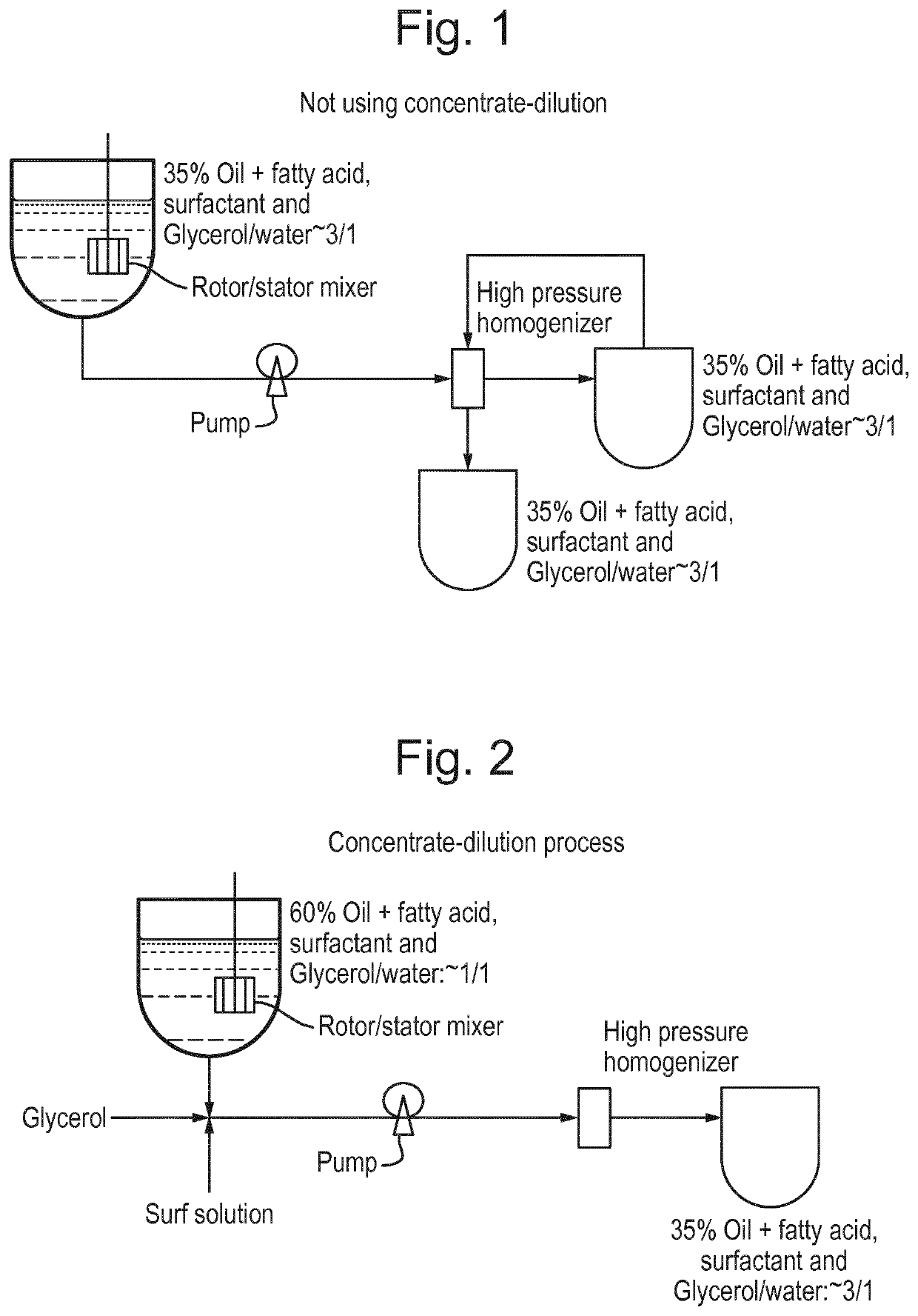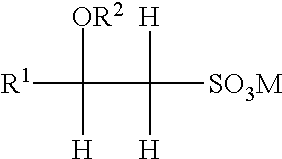Process for making transparent nanoemulsions comprising lauric oil
a technology of transparent nanoemulsions and lauric oil, which is applied in the field of new oil nanoemulsions, can solve the problems of not being considered suitable for oil continuous cleansing liquid compositions, prone to oxidation, and system typical poor lather performance, and achieves less energy consumption and better transparency
- Summary
- Abstract
- Description
- Claims
- Application Information
AI Technical Summary
Benefits of technology
Problems solved by technology
Method used
Image
Examples
examples
[0127]Examples 1-11 and comparatives A-G are to illustrate the non-concentrate-dilution process, while Examples 12-13 are to demonstrate the more energy efficient concentrate-dilution process.
example 12
[0138]The composition as shown in Example 12c of a transparent nanoemulsion is the same as that of Example 7, but was prepared with the method of concentrated emulsion-dilution.
[0139]Step 1: Preparation of Concentrated Emulsion:
[0140]Emulsions were prepared in a one liter ESCO mixer equipped with a rotor / stator high shear device (ESCO-LABOR AG, Switzerland). The aqueous phase, including liquid surfactant, glycerol, and water were added to the ESCO mixer; mixed to uniformity; and heated up to about 30 to about 40° C. The oil phase was combined and heated up to about 40° C. or until melted in a separate container, was gradually added to the aqueous phase in the ESCO mixer under agitation with a scraper. When the addition of all oil phase was completed, the mixture in the ESCO mixer was intensively mixed by the rotor / stator device at 3000 RPM to 7000 RPM (rotor speed) for up to 5 minutes. The oil droplet size was measured by a Malvern Mastersizer.
Example 12aIngredientWt. %Oil PhaseUlti...
example 13
[0146]Example 13 was prepared similarly to Example 12, except that palm kernel oil was used.
[0147]Step 1. Preparation of Concentrated Emulsion
[0148]Example 13a was prepared similarly to Example 12, except that palm kernel oil was used.
Ex 13aIngredientWt. %Oil PhasePalm Kernel Oil56BHT0.2Lauric acid1.4Prisorine ™ 3505 Isostearic Acid3.3Fragrance3.5Aqueous phaseGlycerol15.6WaterQ.S.Eversoft ULS-30S (sodium lauroyl11.0(2.8)*glutamate, 25%)Cocoamidopropyl betaine (38%) 9.0(3.4)*D[4,3] nm158*Number in parenthetical is percent as active ingredient.
[0149]Step 2. The Concentrated Emulsion was Diluted for Further Processing.
[0150]Diluent shown in Example 13b was combined in a one liter ESCO with the concentrated emulsion shown in Example 13a at a ratio of 37.5 / 62.5, arriving a composition as shown in Ex13c.
Example 13bIngredientWt. %Glycerol87.4WaterQ.SEversoft ULS-30S8.4(2.1)*(Sodium lauroylglutamate 25%)Cocoamidopropyl2.6(1.0)*betaine (38%)NaOH0.3*Number in parenthetical is percent as activ...
PUM
| Property | Measurement | Unit |
|---|---|---|
| melting temperature | aaaaa | aaaaa |
| melting point | aaaaa | aaaaa |
| temperature | aaaaa | aaaaa |
Abstract
Description
Claims
Application Information
 Login to View More
Login to View More - R&D
- Intellectual Property
- Life Sciences
- Materials
- Tech Scout
- Unparalleled Data Quality
- Higher Quality Content
- 60% Fewer Hallucinations
Browse by: Latest US Patents, China's latest patents, Technical Efficacy Thesaurus, Application Domain, Technology Topic, Popular Technical Reports.
© 2025 PatSnap. All rights reserved.Legal|Privacy policy|Modern Slavery Act Transparency Statement|Sitemap|About US| Contact US: help@patsnap.com


